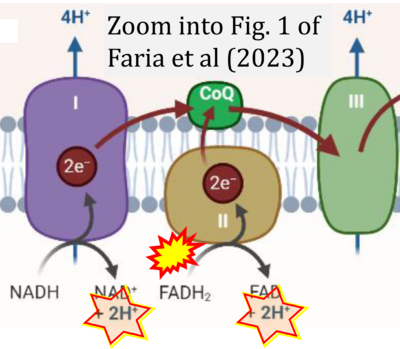Faria 2023 Pharmaceutics: Difference between revisions
(Created page with "{{Publication |title=Faria R, Boisguérin P, Sousa Â, Costa D (2023) Delivery systems for mitochondrial gene therapy: a review. Pharmaceutics 15:572. https://doi.org/10.26124...") |
No edit summary |
||
| Line 8: | Line 8: | ||
|editor=Gnaiger E | |editor=Gnaiger E | ||
}} | }} | ||
[[File:Faria 2023 Pharmaceutics CORRECTION.png|right|400px]] | |||
{{Template:Correction FADH2 and S-pathway}} | |||
{{Labeling | {{Labeling | ||
|area=mtDNA;mt-genetics | |area=mtDNA;mt-genetics | ||
|enzymes=Complex II;succinate dehydrogenase | |enzymes=Complex II;succinate dehydrogenase | ||
}} | }} | ||
Revision as of 18:57, 28 September 2023
| Faria R, Boisguérin P, Sousa Â, Costa D (2023) Delivery systems for mitochondrial gene therapy: a review. Pharmaceutics 15:572. https://doi.org/10.26124/mitofit:2023-0003.v610.3390/pharmaceutics15020572 |
Faria R, Boisguerin P, Sousa A, Costa D (2023) Pharmaceutics
Abstract: Mitochondria are membrane-bound cellular organelles of high relevance responsible for the chemical energy production used in most of the biochemical reactions of cells. Mitochondria have their own genome, the mitochondrial DNA (mtDNA). Inherited solely from the mother, this genome is quite susceptible to mutations, mainly due to the absence of an effective repair system. Mutations in mtDNA are associated with endocrine, metabolic, neurodegenerative diseases, and even cancer. Currently, therapeutic approaches are based on the administration of a set of drugs to alleviate the symptoms of patients suffering from mitochondrial pathologies. Mitochondrial gene therapy emerges as a promising strategy as it deeply focuses on the cause of mitochondrial disorder. The development of suitable mtDNA-based delivery systems to target and transfect mammalian mitochondria represents an exciting field of research, leading to progress in the challenging task of restoring mitochondria's normal function. This review gathers relevant knowledge on the composition, targeting performance, or release profile of such nanosystems, offering researchers valuable conceptual approaches to follow in their quest for the most suitable vectors to turn mitochondrial gene therapy clinically feasible. Future studies should consider the optimization of mitochondrial genes' encapsulation, targeting ability, and transfection to mitochondria. Expectedly, this effort will bring bright results, contributing to important hallmarks in mitochondrial gene therapy.
• Bioblast editor: Gnaiger E
Correction: FADH2 and Complex II
- FADH2 is shown as the substrate feeding electrons into Complex II (CII). This is wrong and requires correction - for details see Gnaiger (2024).
- Gnaiger E (2024) Complex II ambiguities ― FADH2 in the electron transfer system. J Biol Chem 300:105470. https://doi.org/10.1016/j.jbc.2023.105470 - »Bioblast link«
Labels: MiParea: mtDNA;mt-genetics
Enzyme: Complex II;succinate dehydrogenase


